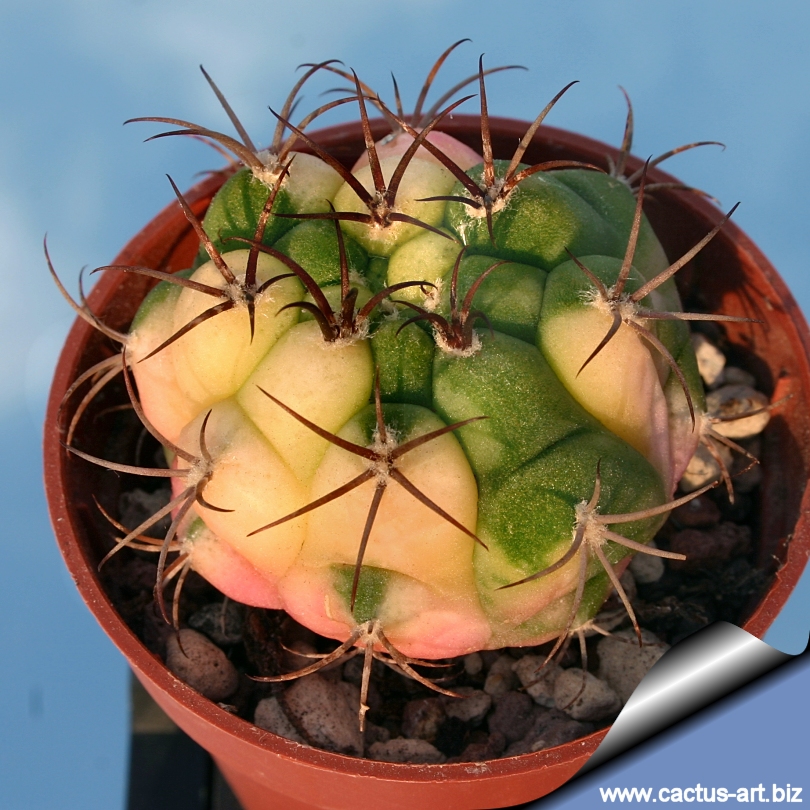|
|
|

Gymnocalycium marquezii variegata (G. pflanzi)
This beauty has a green body variegated
in yellow-cream and pink, it has also fairly heavy
spines bent backward in a distinctive fashion.
|
|
Description: Solitary or
slowly clustering, with peculiar spine clusters characteristically bent
backward in a distinctive fashion.
Stem: Flattened-globose,10-15 (25)cm in diameter, 10cm tall pale
green, to olive green that can tinge of
orangish purple in full sun. The epidermis has a velvety appearance. The
apex is slightly depressed and woolly.
Ribs: 10 to 12 thick, large, divided into polygonal rounded
(not chinned)
tubercles, separated by arched furrows.
Roots: Fibrous
Areoles: Large long, oval 10x14 mm, with cream-yellowish wool,
then blackish dismantling with time.
Spines: Strong, very stiff, bent backward, initially blackish
with a brown base then becoming grey-pinkish to whitish brown with black
point.
Radial spines: (5-)7-9 up to 25 mm long
Central spines: One (or two) of the same length.
Flowers:
Infundibuliform near the apex, diameter and height 45-50mm.
Pericarpell dull green very short. External
tepals spatulate, slightly bent outward , white with brownish green
midrib. Inner tepals intern narrower, spatulate and slightly
denticulate, white with carmine/pink purplish throat. Style carmine with
carmine pink 10-12 lobes. Pollen yellow.
Fruit: Globose of approximately 2 cm of diameter, becoming red
carmine with maturity. Pulp intense cherry-red.
Seeds: Microsemineum type, section pirisemineum, very small (0.6
X 0.4mm),
testa reddish shining and smooth.
NOTE: G. marquezii is very
similar in
structure to G. pfanzii var. riograndense but has shark
mat type skin, dark coppery red stem and dark spines
|
|
 |
 |
|
Advertising
|
|
|
|
|
Family:
Cactaceae (Cactus
Family)
Gymnocalycium marquezii Cárdenas
in:
Die Gattung Gymnocalycium in Bolivien.- Kakt. Sukk. 9(2): 26-27, ills.
1958
Type: Cárdenas 5066 – Bolivia: Tarija, Entre Rios, “near Angosto de
Villa Montes” [protologue, translated] / “Angosto de Villa Montes, 600
m” [holotype], 600 m, 3.1952 (type herbaria: LIL). LIL 531592 (holotype):
rad, corp, ar, sp, fl, ic.
Accepted
Scientific name: Gymnocalycium pflanzii (Vaupel)
Werdermann 1935
Origin:
Garden origin (Nursery
produced cultivar)
Etymology: Named in the honour of
Dr. J. L.
Marquez
Conservation status: Listed in
CITES appendix 2.
Synonyms:
- Gymnocalycium marquezii
Cárdenas1958
- Gymnocalycium
pflanzii var. marquezii
-
Gymnocalycium marquezii var. argentinense Backeberg
nom.
inval. (Art.8.2) In: Kakteenlexikon: 169, Abb. Seite 566 (1966).
|
|
|
|
Cultivation: Gymnocalycium are very
gratifying plants, their culture is easy and their flowering is abundant
if we give them a well drained relatively rich substrate (if possible
not limestone) Water regularly in
summer (but do not overwater ) keep rather dry in winter,
need frequent repottings and a very luminous exposure but avoid
direct exposure to the sun rays. This species is particularly easy and
accommodating, seldom suffer of
cryptogamic diseases. Feed with a high potassium
fertilizer in summer.
Hardy as low as -5° C (or less)
if kept dry.
Special cares for
variegated forms: In the
summer it is best to avoid direct sun during the hottest hours of
the day (but they benefits from morning sun, that helps to produce
strong and colourful spines). In case of cultivation in a sunny
place it is best to plant with the variegated spot facing
northeast, so it gets the least amount of direct sunlight as possible.
Propagation: Usually by
Seeds (Seeds should be sown in a well-drained soil mix. Surface sowing
is the best; seeds germinate in 14-28 days at 25° C, or from
cuttings in spring (let them dry till the ends callous well). Then
replant them in fresh cactus soil that is ever so slightly moist, and
keep it that way till they root). The grafting is useless (excluded the
cultivars completely deprived of chlorophyll), it does not bring
anything concrete
Variegation: A variegated plant has sectors, patches or stripes
with two or more different colours, even distinct shades of green.
Plants with variegated stems or leaves are often
attractive and
highly prized.
In most species the
stems or leaves are normally green, and variegated epidermis is an
uncommon
mutation, termed a
chimera. A chimeral variegation is due to losing the ability to
produce
chlorophyll in some of the plant’s
tissue, so that this tissue is no longer green. Tissues lacking
chlorophyll are usually white or pale yellow coloured (due to
carotenoid
pigments) or red (due to
betalain or
anthocyanin pigments) contrasting with the normal green tissue.
There are several forms of variegation, depending on the tissues that
have been affected. The variegation in some forms is unstable. The
extent and nature of the variegation can vary, and sometimes the plant
will return to the green form. In others it is stable and does not
change under normal conditions. Because the variegation is due to the
presence of two kinds of plant tissue, propagating the plant must be by
a
vegetative method of
propagation that preserves both types of tissue in relation to each
other.
Variegated Gymnocalyciums are very rare and priced
in
cultivation. All variegates are
mutants. Something has gone wrong with the cellular structure of the
growth tip (apical
meristem) of the plant. As a result of this mutation,
chlorophyll is missing from some or all layers of the plant
epidermis. The odd variegate appears in many seedling batches in a
small percentage, and is generally separated from normal plants.
Variegated plants grow more slowly, and are generally smaller than
non-variegates of the same species. Coloured areas are also generally
weaker, and more
susceptible to
fungus,
sunburn and other defects. A large well grown variegate
Gymnocalycium
is truly an achievement. These are harder to grow well than they appear.
Photo of conspecific taxa, varieties, forms and cultivars of
Gymnoclycium pflanzii:

 |
|